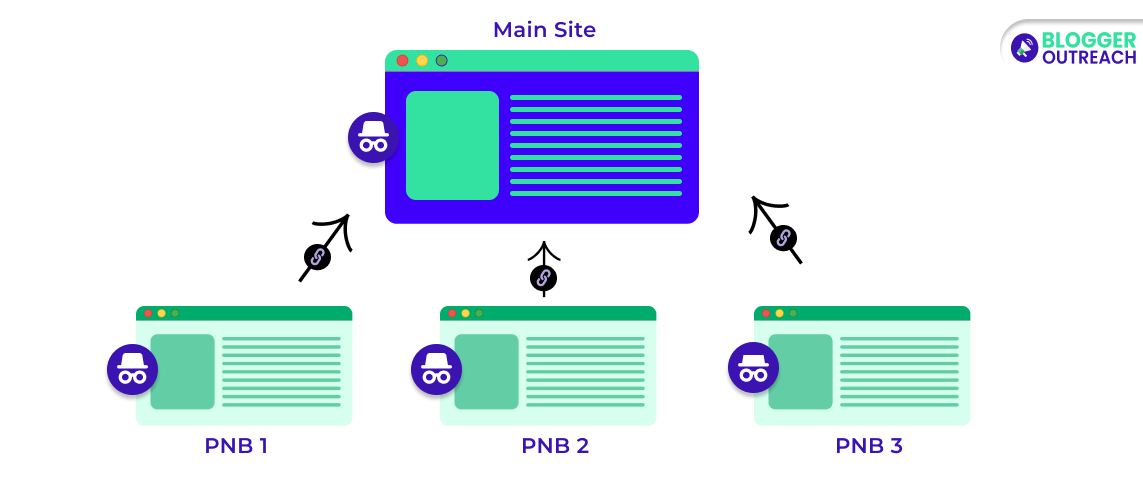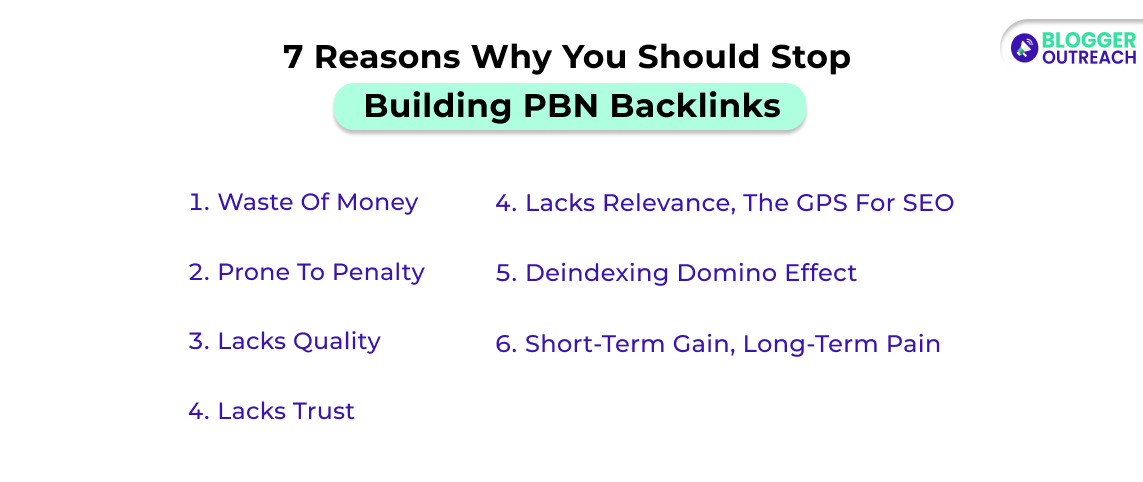Table Of Content
- 1 What Are PBN Backlinks (With example)?
- 2 History Of PBN Backlinks
- 3 PBN Footprints – Factors That Signal Google A Website Is Part Of A PBN
- 4 How Do You Identify PBN Backlinks?
- 5 How Most People Create PBN Backlinks?
- 6 7 Reasons Why You Should Stop Building PBN Backlinks
- 7 So, Stop Making PBN Backlinks – Do This INSTEAD
- 8 Final Words
PBN backlinks are link spam.
And that is why Google dislikes them.
For those who do not know, link spam is the practice of manipulating PageRank for higher rankings.
(PageRank is an algorithm that ranks pages based on quality and link quality).
Now, if you have been here for some time, you may be wondering:
Google’s guidelines and the actual practices of SEO differ a little (sometimes).
Yes, it is true.
For instance, paid links aren’t 100% Google’s guidelines-friendly.
But they’re becoming more common as they work wonderfully. And publishers make money with that. But you need to understand that paid links can also be beneficial, provided they follow the right practices.
Anyway, let’s come to PBN backlinks.
For PBN backlinks, you must comply with Google’s policies.
We do not recommend building links on PBNs. They are easy to detect by Google.
and many sites that use them get penalized.
BloggerOutreach never uses PBNs to build links.
Anyway, let’s get back to your quest for PBN backlinks.
We are here to share the complete guidance with you.
You Will Learn:
- What are PBN backlinks (With example)?
- History of PBN backlinks.
- PBN Footprints – Factors That Signal Google a website is Part of a PBN.
- How do we identify PBN backlinks?
- Why Should You Stop Making PBN Backlinks?
- Stop Making PBN Backlinks – DO this instead.
What Are PBN Backlinks (With example)?

PBN backlinks, also called Private Blog Network backlinks, are links that point to a target website through a network of privately owned sites.
Simply put, there would be a host site and another privately hosted site. The latter sends links to the host site.
For example, let’s say a website owner has an active fitness blog (target site). With this PBN technique, they create a network of 15 privately owned websites. Each website focuses on a different fitness sub-niche, such as weight loss, muscle building, and yoga.
The site owner then strategically places backlinks within the content of these privately owned sites, directing them to the target site.
And the point is clear: sending more links to one site will improve their rankings.
So, here is the gist: PBN is hosting multiple sites and linking them to a main website.
History Of PBN Backlinks
Once upon a time, PBN backlinks were the SEO tool to rank higher. Life was easy for search engine manipulators until the Penguin update of 2012-13 crashed the party.
Post-Penguin, the PBN empire crumbled. The update identified link schemes and prevented authority transfer from such links.
But wait, the manipulators found another hack. They started buying expired domains and sending PBN backlinks. Yes, we are talking about the time PBN backlinks were a service.
Instant results—oh, the allure! PBN backlinks provide a quick fix, boosting traffic and rankings in the blink of an eye.
But the joy was short-lived.
Again, Google figured out that this was a malpractice.
Traffic dropped, and penalties came into the picture.
Today, despite the likelihood of penalty, People still use PBN for backlinks.
Now, they try to manipulate the factors that signal Google about a PBN site. They try not to leave any footprint that is detected by the algorithm.
(Footprints are signals that help the algorithm name that a blog is a part of the PBN network.)
PBN Footprints – Factors That Signal Google A Website Is Part Of A PBN
- Hosting – On same IP/Same date registration.
- Site design – common design, theme, type of content.
- Site ownership/who is.
- Content Duplication.
- Similar backlinks.
- Same Google Analytics account.
- All domains linking to the main website.
How Do You Identify PBN Backlinks?
Utilize tools like Ahrefs to scrutinize backlink profiles. Evaluate domains with high DA/DR, low traffic, fewer keywords in the top 100, and near-zero-page traffic.
Then, build a list of potential PBN domains and analyze them using a checklist:
(Avoid these red flags)
Firstly, the certain influx of traffic. For example, 20k traffic in 2 days with very few ranking keywords Alarming?
Anchor Text Density. Spot unnatural anchor text density, especially repetitive use of specific keywords.
Examine header and footer elements for visual cues. PBNs often reuse designs and themes across multiple domains. Look for patterns indicating a common origin.
PBNs often exhibit inflated metrics like DA and DR. Analyze backlinks carefully to differentiate between genuine and manipulated metrics.
Moreover, the content is typically thin, AI-generated, or spun from existing articles. Analyze content for relevance and quality.
Plus, these domains lack organic traffic and rank for irrelevant keywords. Scrutinize the backlinks of such domains to uncover the manipulation of authority.
PBNs may share IP addresses, subnets, or hosting technologies. So, detect patterns in IP addresses to identify potential PBNs.
Use tools like SEMrush to identify common referring domains. Unusually high ratios of dofollow/nofollow links can indicate PBN involvement.
Next, Quick Domain Analysis Tips:
- Batch Analysis: Use tools like Ahrefs, Semrush, and SpyFu for batch analysis. Identify domains with unusually high backlinks compared to referring domains.
- External Links on Homepage: PBNs may have a separate section on their homepage with links to external domains.
- Blogspot/WordPress/Google Sites Links: Analyze backlink profiles for links from microblogging or community sites. Distinguish between natural and artificially generated links.
- Suspicious Link Network Visualizer: Use link graph visualizers to identify clusters of suspicious domains. Investigate further using other PBN checks.
How Most People Create PBN Backlinks?
So, there are two ways black hat advocates use these days.
1. Building Your Own Empire
Picture this: You build a network, keep it under wraps like a poker hand, and strategically link back to your sites. It’s like having a secret society, and it might just work for a while.
2. The Dark Art Of Buying Links
Now, let’s talk about the shortcut takers who opt for the express lane by buying PBN backlinks. It’s like a digital shopping spree – a quick way to amass links in no time. Sounds tempting, right?
But hold your horses. The sellers of these links aren’t always the SEO experts you might hope for.
And here’s the kicker – buying links from these networks is akin to tossing money into a wishing well. The links are often ineffective, and the promised benefits?
So, why the cautionary tale?
7 Reasons Why You Should Stop Building PBN Backlinks

Let’s reduce the noise and have a heart-to-heart talk about Private Blog Network (PBN) backlinks.
If you are still dancing on the PBN stage, it’s time to take a step back.
Brace yourself for 7 reasons why breaking up with PBN backlinks is high time.
1. Waste Of Money
PBN backlinks can get you quick results. But that doesn’t last for a long time. In fact, you are prone to a penalty or a ranking drop. Thus, by building PBN backlinks, you are affecting the health of your site. So, it is an act of wasting your money that won’t get long-term results.
2. Prone To Penalty
Google, the digital watchdog, sees all. Trying to slip past its algorithm with PBN backlinks is like sneaking a cookie before dinner – sooner or later, you’ll be caught. Google values authenticity, and PBNs don’t exactly scream “trust me.”
3. Lacks Quality
Think of backlinks as your digital posse – it’s not about having the most; it’s about having the right ones. PBNs often serve up low-quality links, like a buffet with more filler than flavour. Google’s recipe for success? Quality over quantity every single time.
4. Lacks Trust
In the vast landscape of the internet, trust is the unsung hero. PBNs? They’re more like digital tricksters, undermining the trust your site has worked so hard to build. Google and your audience alike can smell deception – don’t let your reputation take the hit.
5. Lacks Relevance, the GPS For SEO
Let’s talk about relevance. PBNs often bring links from the left field, confusing Google’s SEO GPS. Your content deserves links that make sense, not a digital scavenger hunt. Stick to the relevance roadmap for SEO success.
6. Deindexing Domino Effect
Think of PBNs as a house of cards – if one falls, they all come tumbling down. Google’s deindexing power can turn your website into a ghost town. One shaky PBN link and your entire digital neighbourhood might vanish.
7. Short-Term Gain, Long-Term Pain
Sure, PBNs might give you a quick SEO sugar rush (a quick ranking), but it’s short-lived. The long-term pain of penalties and potential deindexing isn’t worth the fleeting high. So, play the long game for sustainable success.
So, be cautious!
Because in the world of PBNs, there’s no such thing as a free lunch. Whether you’re building your own covert network or swiping your credit card for links, the risks outweigh the rewards.
So, Stop Making PBN Backlinks – Do This INSTEAD
Get yourself seamlessly into Google’s ecosystem.
What if we tell you that there is a way to contribute to the Google ecosystem that gets you links?
Well, we are talking about guest posting.
(Our regular readers already know this.)
Through guest posting (or guest blogging), you can write and publish quality articles on authoritative websites. And, as a token of appreciation, they point a link back to your website.
This inbound link (backlink) is your digital recommendation.
Similarly, when you get these types of links from more top-tier sites.
Google perceives you as authentic and popular.
Thus, it promotes you higher in search results.
But guest posting can give you results provided you do it CORRECTLY.
The Best Practices Come With The Following:
- Finding the right (relevant) prospect for your brand.
- Building a meaningful relationship that opens up guest posting opportunities.
- Then, find the content gaps in the publisher’s site and curate your content strategy.
- Next, creating SEO & E-E-A-T optimized content for readers and search engines alike.
- Ensuring a seamless and natural anchor text placement that improves the overall user experience.
- Following up with the publisher and ensuring a permanent link.
Understood? Well, you can also read our step-by-step guest posting guide for better clarity.
Final Words
Backlinks are super important for rankings, and there is no doubt about that.
But that doesn’t necessarily mean that you are on the wrong path.
In the above section, we have already shared a proven way (guest posting) to grow your backlink profile.
In case you need any help, let us know how we can help you.
If you are a new visitor to our website, we are the world’s leading B2B SEO agency catering to world-class brands, SEO agencies, and entrepreneurs.
If you want to know more about our approach towards our clients, look at our case studies.
Read Also:








